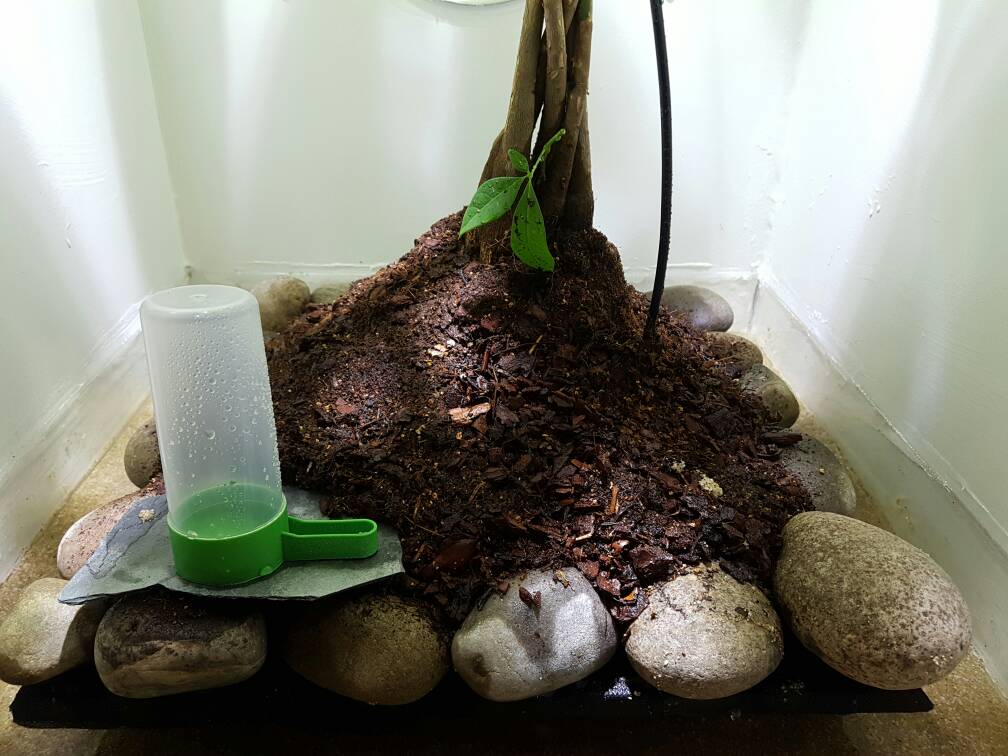Formicarium of the 2/4
This quarter we're happy to bring you a brief look at an Oecophylla smaragdina formicarium from Viktor Underwood.
The size of the formicarium and nest areas.
The size of the formicarium is 60×60×120cm tall, the island is 44×44cm, the tree is 70cm. As for the nest, there appears to be no pattern to their nests they seem to pick some leaves, swarm over them for an hour then you start to see organisation, within 3-4 hours it can go from a few leaves to a fully formed nest held together with silk and detritus.
The materials used for the formicarium.
I used a standard arboreal vivarium but used acrylic as a basin to keep the bottom watertight for my moat. I routed a hole in the top for an exo terra sun ray fixture set for 12 hours on/12 off and a hole in the back for an exo terra ceramic basking lamp controled by a pulse proportional thermostat all siliconed into place. I painted the exterior and interior outdoor gloss to protect the vivarium from heat and humidity. I attached two 120mm pc fans to the ceiling to create airflow.
The island was created from reef eggcrate covered in substrate mesh. To stop the substrate from falling into the moat I siliconed cobble stones in a boarder around the island. I then placed the pachira aquatica tree in the center of the island and backfilled it with bioactive substrate with added vermiculite to retain water.
The time it took to build the formicarium.
It took about 2 months to plan and build including countless hours of research and it cost about £400 not including the colony.
How successful the formicarium has been.
In my opinion the enclosure has been very successful, it maintains a constant temperature gradient from 26°c at ground level to 29°c at the apex of the tree, due to the moat it keeps a nice humidty of 50-60% and provides escape prevention.
Hydration methods.
I hydrate the nest by misting daily.
Feeding methods.
For protein I only feed live food which is placed randomly on the tree including, medium sized crickets, grasshoppers, locusts, calci worms, bean weevils and fruit flies. I've noticed the colony prefer wax worms and dislike mealworms. In terms of sugar I give them only organic sugar water, local honey and maple syrup. I have a feeding station in the canopy which is essentially a piece of slate with bottle tops that act as feeding bowls and randomly placed water test tubes. I also have a feeding station on the ground which is more bottle top feeding bowls.
Daily/Weekly Maintenance
Maintenance includes removing dead insects from the moat and replacing feeding bowls. Fortnightly I wet and dry vac the moat and replace the water.
Update...
The moat sprang a leak which drastically lowered humidity. The lack of humidity caused the nest to keep dying which meant the colony were making a new nest each week and the tree couldn't keep up. So before the festive holidays I decided to swap the tree for a calamondin tree (citrus mitis), repair the moat and install a mini irrigation system. During the transition I got to see the beautiful queen and the very large brood pile that completely filled up 2 test tubes. Since they have settled in they have created the largest nest to date which they have been using for over a month. I've noticed that the calamondin tree has started losing leaves so I may have to install an automatic misting system.
Thanks for taking an interest in my project, I find this colony extremely fascinating and can literally spend hours watching them.
No, thank you Viktor. What an amazing species of ant I'm sure we'd all love the opportunity to keep one day. Thanks again for sharing.
If you have a unique formicarium or interesting ant species you'd like featured on Gamergate drop us an email, we'd love to hear from you.


















































